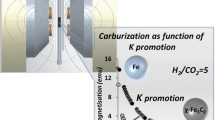Abstract
We present results of a catalyst structure-function study that supports a CO hydrogenation model with α-olefins formed as the principal primary products and n-paraffins formed during secondary hydrogenation reactions. The interplay of catalyst composition and reaction environment controls the extent of secondary reactions. Catalysts that contain mainly oxidic phases or carbides with large concentrations of excess “matrix carbon” favor secondary reactions. The relative concentrations of oxide and carbide phases depends on the ease of reduction of the catalyst, which can be changed by cation substitutions. For example, cobalt substitution into Fe3O4 lowers the reduction temperature by 20 ° C. Excess matrix carbon has been intentionally introduced (by treatment in high temperature H2/CO) into model iron carbide catalysts produced by laser synthesis. Increased paraffin selectivity as matrix carbon is introduced suggests the influence of the diffusion constraints on product selectivity. Alkali promotion will affect secondary hydrogenation pathways. We illustrate how catalysts with low levels of alkali become increasingly more selective to paraffins at high conversions (and high effective H2/CO ratios).
Reaction environment also controls catalyst composition and selectivity. Mossbauer spectroscopy on spent catalysts suggests that oxide/carbide phase formation in iron catalysts are sensitive to reactor configuration (extent of backmixing). In integral fixed bed reactors, catalysts partition into carbide phases in the front of the bed but show increasing amounts of oxide near the exit, whereas the catalysts in the stirred tank reactor remain all carbides. Product selectivities reflect the phase differences.
Other examples illustrating secondary hydrogenation phenomena will be presented.
Similar content being viewed by others
References
M.E. Dry, The Fischer-Tropsch Synthesis, in:Catalysis, Science and Technology, eds. J.R. Anderson and M. Boudart (NY, 1981) Vol. 1, p. 159.
C.D. Frohning and B. Cornils, Hydrocarbon Processing, (Nov. 1974) 143.
B. Cornils, B. Buessmeier and C.D. Frohning, Inf. Ser.-Alberta Res. Council 85 (1978) 126.
B. Buessemeier, C.D. Frohning and B. Cornils, Hydrocarbon Processing, (Nov. 1976) 105.
F. Fischer and H. Tropsch, Brennstoff-Chem. 7 (1926) 97.
V.V. Niemansverdriet, A.M. vander Kraan, W.L. Van Dyk and H.S. vander Baan, J. Phys. Chem. 84 (1980) 3363.
F. Balnchard, J.P. Reymond, B. Pommier and S.J. Teichner,3rd Int. Symp. on Scient. Basis for Prep. of Het. Catal. (Belg), Sept. 1983; and J. Mol. Catal. 176 (1982) 171.
M.E. Dry, T. Shingles, L.J. Boshoff and G.J. Ostuizien, J. Cat. 15 (1969) 190.
J. Benziger and R.J. Madix, Surf. Sci. 94 (1980) 119.
D.L. King and J.B. Peri, J. Cat. 79 (1983) 164.
H. Storch, N. Golumbic and R.B. Anderson,Fischer-Tropsch and Related Synthesis (Wiley N.Y., 1951) Ch. 6.
N.O. Egiebor and W.C. Cooper, Appl. Catal. 17 (1985) 47.
P. Biloen, J.N. Helle and W.M.H. Sachtler, J. Cat. 58 (1979) 95.
G. Henrici-Olive and S. Olive, Angew. Chem. Int. Ed. 15 (1976) 136.
R.A. Fiato and S.L. Soled, U.S. Pat. 4,618,597 (1986).
S.L. Soled and R.A. Fiato, U.S. Pat. 4,544,671 (1985).
S.L. Soled and R.A. Fiato, U.S. Pat. 4,584,323 (1986).
G. Rice, R.A. Fiato and S.L. Soled, U.S. Pat. 4,788,222 (1988).
S. Soled, G. McVicker and B. DeRites,Proc. 11th North American Thermal Analysis Conf., 1981.
M. Nakamura, B.B. Wood, P.Y. Hou and H. Wise,Proc. 7th Int. Conf. of Catal., part 7a, June '80.
R.M. Stanfield and W.N. Delgass, J. Cat. 72 (1981) 37.
Author information
Authors and Affiliations
Rights and permissions
About this article
Cite this article
Soled, S., Iglesia, E. & Fiato, R.A. Activity and selectivity control in iron catalyzed Fischer-Tropsch synthesis. Catal Lett 7, 271–280 (1990). https://doi.org/10.1007/BF00764508
Issue Date:
DOI: https://doi.org/10.1007/BF00764508




